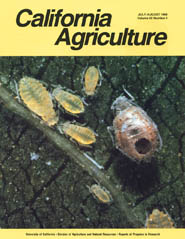All Issues

Cover:
Unless disrupted by sprays for other walnut pests, a parasitic wasp usually keeps walnut aphids under control in orchards. Aphid mummy, seen with walnut aphids on a leaf in the cover photo, shows evidence of parasitization by the wasp, Trioxys pallidus, which lays an egg inside each aphid host. The developing parasite kills the aphid, transforms it into a mummy, and eventually emerges as an adult. Researchers have developed a resistant strain of the wasp, which they hope will be able to survive Guthion sprays applied to control coddling moth and navel orangeworm in walnut orchards. Cover photo by Jack Kelly Clark
July-August 1988
Volume 42, Number 4
Volume 42, Number 4





